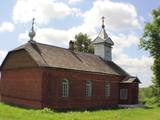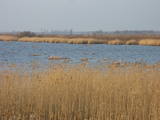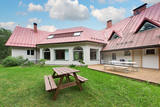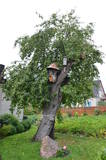| Nr | Name | Beschreibung |
|---|---|---|
|
Errichtet an der Stelle, an der im Ersten Weltkrieg 1916 die sogenannte Weihnachtsschlacht der russischen gegen die deutschen Truppen stattfand. Nach dieser Schlacht wurde der Mut und die Heldenhaftigkeit der lettischen Schützen weit über die Landesgrenzen hinaus bekannt . Auf dem Ložmetējkalns (Maschinengewehrberg) ist eine Gedenkstätte für die lettischen Schützen errichtet und ein Aussischtsturm erneuert worden. Von dort aus sieht man das Maztīreļa purvs (Kleinheide Moor), die Stelle, an der ehemals eine deutsche Schmalspurbahn in Nord-Süd Richtung kreuzte, ist noch gut zu erkennen. Hier kann man sich auf eine Wanderung mit oder ohne Führer begeben, das Mangalis-Haus des Weihnachtsschlachtmuseums besuchen, in dessen Nachbarschaft eine Erkundungsroute errichtet ist, oder an thematischen Bildungsveranstaltungen und Schlachtimitationen teilnehmen. Zu besichtigen sind Denkmäler, Soldatengräber, Ausgrabungen, Fortifikationen, Erdhütten und mehr. Es gibt auch einen an autentischer Stelle rekonstruierten Abschnitt eines Befestigungssystems – einen Schutzbau und einen Teil der ersten deutschen Schutzlinie, den sogenannten „deutschen Wall“. |
||
|
Der Familienhof züchtet und baut wie in alten Zeiten alles, was man zum Leben und für die Gesundheit braucht, an oder fertigt es selbst: Getreide, Hanf, Gemüse, Obst, Vieh und mehr als 60 Heilpflanzen, aus denen dann originelle Produkte entstehen. Zusammen mit der Hausherrin kann man sich im Bestimmen der Pflanzen üben, Kräutertees verkosten und auf dem Gartenkamin Gewürzbrot backen. Im Gesundheitshaus kann man zusehen, wie Öl gepresst, Blumenwasser destilliert wird und wie nach alten Rezepturen natürliche Kremes und Salben gefertigt werden. Die Produkte kann man auch kaufen. 1991 begannen die Hausherren mit der Durchführung von Kursen zum ökologischen und biodynamischen Landbau, wobei der eigene Hof als Muster fungierte. Seit 2000 werden hier Kräuterteemischungen und Gewürzmischungen unter der Marke „AnnaABergmans“ hergestellt. 2015 kam die Fertigung von Salben, Kremes und Destillaten hinzu. |
||
|
Die Insel Kihnu ist die größte Insel in der Rīgaer Meeresbucht und die siebtgrößte estnische Insel. Ihre Gesamtfläche beträgt 16,9 km², die Insel ist 7 Kilometer lang und bis zu 3,3 Kilometer breit. Die ehemalige Robbenjäger- und Fischerinsel mit ihren derzeit ca. 600 Einwohnern kämpft hartnäckig um die Aufrechterhaltung ihrer Identität. Die einzigartigen Eigenschaften des als UNESCO-Weltkulturerbe geadelten Kulturraums von Kihnu sind die Lebensart der Gemeinde, die vielseitigen Kulturtraditionen, eigene Sprache, Musik, Volkstracht und Natur. Um die Kultur- und Naturvielfältigkeit der Insel Kihnu zu entdecken, ist am besten die Küstenroute geeignet, die die vier Dörfer Sääre, Linaküla, Rootsiküla und Lemsi durchquert. Das Museum von Kihnu heißt das ganze Jahr hindurch Besucher willkommen. Es verschafft einen Überblick über die Geschichte der Insel, darunter auch über das Leben des berühmten Kapitäns Kihnu Jõnn. Sehenswert sind auch die Kirche von Kihnu und der Friedhof, der sich gegenüber von dem Museum befindet. Vom Leuchtturm aus kann man im Sommer einen wunderbaren Ausblick auf die Insel, die umliegenden Sandbänke und das Meer genießen. Der Gedenkstein am ehemaligen Haus von Kihnu Jõnn berichtet über den legendären „wilden Kapitän“ der Insel. |
||
|
Bоrisovas St. Nikolay Old-Believers Prayer House was built in the period of 1911 – 1921 . The different feature of the Prayer House is a brick building placed on the hill. The bell of the temple was specially
ordered and brought from St. Petersburg. The bell has a very soft sound.
|
||
|
Apdzīvota vieta ~ 1 km dienvidos no Daugavpils – Krāslavas (A 6) ceļa, kas pazīstama ar savu neparasto nosaukumu. Interesanti, ka vietvārds saistīts arī ar iedzīvotāju uzvārdiem, ko var redzēt tāda paša nosaukuma kapos. Ciema apkaimē pazīstams ir Lielo Muļķu svētavots, kuru gan nezinātājam ir grūti atrast, tādēļ ieteicams izmantot vietējā gida pakalpojumus, apvienojot šīs vietas izziņu ar biškopības saimniecības „Cīruļi” apskati. |
||
|
Auf den ordentlichen und schmucken Feldern des Hofes „Ezerlīči“ blühen Lilien, Pfingstrosen und Taglilien. Ein schöner Steingarten wurde bereits angelegt und ein dendrologischer Park ist im Entstehen begriffen. Über 100 Bienenvölker sammeln Nektar. Die Hausherrin bietet Führungen an und diverse Pflanzen und Imkereiprodukte stehen zum Verkauf. |
||
|
In der Zauberküche werden leckere Speisen aus den in der Gegend angebauten Produkten angeboten. Sie sollen unbedingt die Brennesselsuppe kosten, die als die beste südestnische Suppe gilt. Nõiariik ist für die aktive Erholung sowohl für Familien als auch für größere Gruppen geeignet. |
||
|
Der Ziergarten der Familie Klugs ist als einer der schönsten Gärten in Lettland anerkannt. Die Inhaber empfehlen den Monat Juli für einen Besuch, wenn die Sommerblumen in allen Farben erblühen. Um den erfüllten Traum der Familie Klugs, in einem Park zu wohnen, mit eigenen Augen zu sehen, muss man auch auf die für das Landschaftsbild Lettlands typischen einzelnen großen Laubbäume achten, die den Park ergänzenden Bepflanzungen mit Nadelbäumen und schließlich die Grünanlagen aus Ziersträuchern, die über viele Jahre hinweg gepflanzt wurden. |
||
|
Ein seichter, eutrophischer (mehr als 60% Sättigung), lagunenähnlicher See, dessen Schutzgebiet den überwuchernden See und die ihn umgebenden Feuchtwiesen erhalten soll. Es gibt mehr als 60 Arten von Nistvögeln in dieser Gegend. Das Dammsystem am Südufer des Sees kann von den Besuchern als Beobachtungsstandort genutzt werden.
|
||
|
Atpūtas centrā tiek piedāvāta iespēja atpūsties brīvā dabā kolektīviem vai individuāliem apmeklētājiem. Iespējams izmēģināt dažādus metamos ieročus (nažus, cirvjus u.c.), kā arī šaušanu ar dažāda veida lokiem, arbaletiem, pneimatiku u.c. |
||
|
Conference and recreation center "Zvīguļi" is located in the territory of Gauja National Park, 10 km from Sigulda - with picturesque and untouched nature on one side and Sigulda highway (A2) on the other. From the inner courtyard there is a forest, from which, walking along a relief, nature-created and well-groomed path, you will reach the bank of the river Gauja in 15 minutes. It offers accommodation in rooms of different comfort or in a common room. There is a spacious and modern kitchen. The guest house also has a quadruple Finnish sauna. If necessary, catering will be provided by our partners. Active leisure opportunities nearby - toboggan run, bicycle rental, fishing, boating, quad and motorcycle track, horse riding. |
||
|
Die Wirtschaft Joži kann man in Jaunpils, am Rande der Straße Jaunpils – Viesata finden. Diese Wirtschaft ist eine der größten Wirtschaften für Getreidepflanzen (Wintergetreide, Sommergetreide und auch Rapse) in Lettland, deren Anfänge Ende der 1980er und Anfang der 1990er Jahre zu finden sind. Zurzeit befinden sich in der Wirtschaft 14 Getreidetürme und eine Rekonstruktion erlebt das Darrhaus. Insgesamt werden 5000 ha bewirtschaftet, ein moderner Park mit landwirtschaftlicher Technik ist gebildet worden. Die Wirte Guna und Gunvaldis Sproģis nehmen aktiv an verschiedene EU-Projekte teil. Gewinner und Preisträger von verschiedenen Wettbewerben. |
||
|
There are three craters here, and the biggest one, known locally as Põrguhaud, or Grave of Hell, has a diameter of 80 m and a depth of up to 12 m. There are barriers around the crater that are several metres high. The other two craters are hard to spot. The craters around 6,000 years old. No scraps of the supposed meteorite have been found, however, and so the origins of the craters cannot be confirmed with certainty.
|
||
|
Einer der seltenen Orte, wo eine kleine Gruppe (2 bis 3 Personen) sich in einem Fischerboot auf die See begeben und den Küstenfischfang beobachten kann. In Zusammenarbeit mit anderen Fischern wird diese Möglichkeit auch an größeren Gruppen angeboten. Der auf dem Fluss Svētupe gebaute Neunaugen-Fischzaun unterscheidet sich in seinem Aufbau und in der Art des Fischfangs von den Fischzäunen auf dem Fluss Salaca. |
||
|
Ein ruhiger Ort bei der Natur, wo man sich herrlich erholen kann. Das Essen wird aus lokalen Produkten von Hiiumaa auf Wunsch der Gäste zubereitet. Darüber hinaus kann man eine authentische Sauna mit Holzofen und ein Bad im Bottich genießen. Es gibt einen Kinderspielplatz. |
||
|
Inese bakes honey, chocolate and cottage cheese tortes, using only natural ingredients from Latvia. Visitors can learn how to bake tortes, taste and purchase them, and order cakes for themselves. |
||
|
Находится в подвальном этаже Лигатненского дома культуры. Летом у реки Лигатне работает открытая терраса. Латышская кухня: Селедка, холодный суп, купаты, свиные котлеты, охотничьи колбаски, свиные ребрышки, блины с творогом, картофельные блины. Особое блюдо: Свиной карбонад «У Яньчука». |
||
|
Самая старая яблоня в Литве, плодовое дерево, представляющее собой ботанический объект природного наследия. Вид дерева: яблоня лесная. Это единственная яблоня в Литве, которая находится под охраной государства. |
||
|
От родного дома Атиса Кронвалда (1837 – 1875) – выдающегося латышского публициста, педагога и языковеда – «Леяс Мики» в Кроте Приекульского края ничего до сегодняшнего дня не сохранилось. На месте дома установлена мемориальная плита с надписью «Для каждого священно то место, где родился и вырос» (А. Кронвалдс). |
||





























